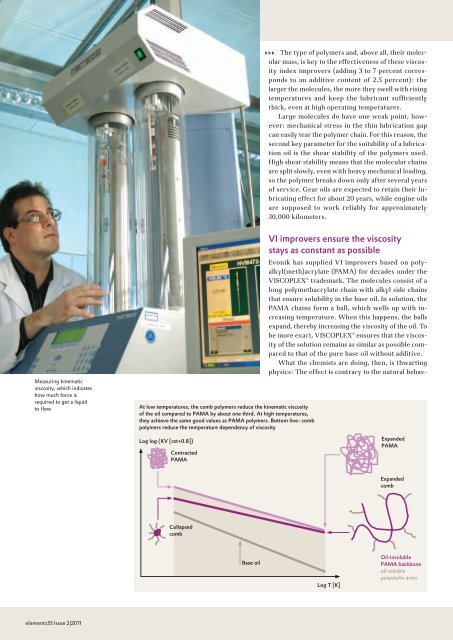Download - Evonik Industries
Download - Evonik Industries
Download - Evonik Industries
You also want an ePaper? Increase the reach of your titles
YUMPU automatically turns print PDFs into web optimized ePapers that Google loves.
10 DesIGnInG WItH PoLYMeRs<br />
Measuring kinematic<br />
viscosity, which indicates<br />
how much force is<br />
required to get a liquid<br />
to flow<br />
elements35 Issue 2|2011<br />
At low temperatures, the comb polymers reduce the kinematic viscosity<br />
of the oil compared to PAMA by about one third. At high temperatures,<br />
they achieve the same good values as PAMA polymers. Bottom line: comb<br />
polymers reduce the temperature dependency of viscosity<br />
Log log (KV [cst+0.8])<br />
Contracted<br />
PAMA<br />
Collapsed<br />
comb<br />
Base oil<br />
333 The type of polymers and, above all, their molecular<br />
mass, is key to the effectiveness of these viscosity<br />
index improvers (adding 3 to 7 percent corresponds<br />
to an additive content of 2.5 percent): the<br />
larger the molecules, the more they swell with rising<br />
temper atures and keep the lubricant sufficiently<br />
thick, even at high operating temperatures.<br />
Large molecules do have one weak point, however:<br />
mechanical stress in the thin lubrication gap<br />
can easily tear the polymer chain. For this reason, the<br />
second key parameter for the suitability of a lubrication<br />
oil is the shear stability of the polymers used.<br />
High shear stability means that the molecular chains<br />
are split slowly, even with heavy mechanical loading,<br />
so the polymer breaks down only after several years<br />
of service. Gear oils are expected to retain their lubricating<br />
effect for about 20 years, while engine oils<br />
are supposed to work reliably for approximately<br />
30,000 kilometers.<br />
VI improvers ensure the viscosity<br />
stays as constant as possible<br />
<strong>Evonik</strong> has supplied VI improvers based on polyalkyl(meth)acrylate<br />
(PAMA) for decades under the<br />
VISCOPLEX® trademark. The molecules consist of a<br />
long polymethacrylate chain with alkyl side chains<br />
that ensure solubility in the base oil. In solution, the<br />
PAMA chains form a ball, which wells up with increasing<br />
temperature. When this happens, the balls<br />
expand, thereby increasing the viscosity of the oil. To<br />
be more exact, VISCOPLEX® ensures that the viscosity<br />
of the solution remains as similar as pos sible compared<br />
to that of the pure base oil without additive.<br />
What the chemists are doing, then, is thwarting<br />
physics: The effect is contrary to the natural behav-<br />
Log T [K]<br />
Expanded<br />
PAMA<br />
Expanded<br />
comb<br />
Oil-insoluble<br />
PAMA backbone<br />
oil-soluble<br />
polyolefin arms
















